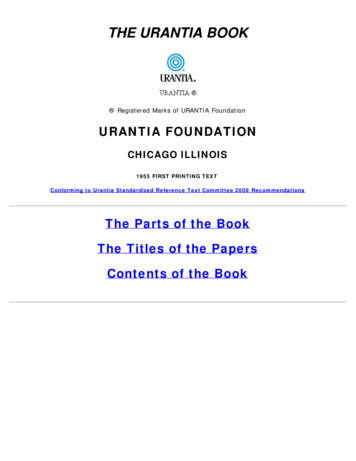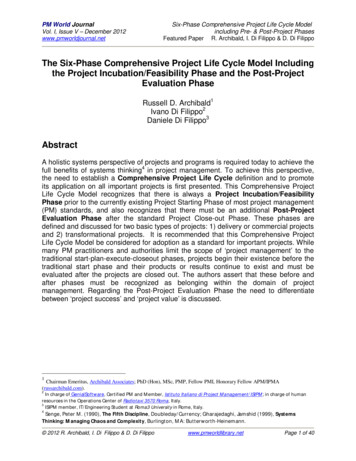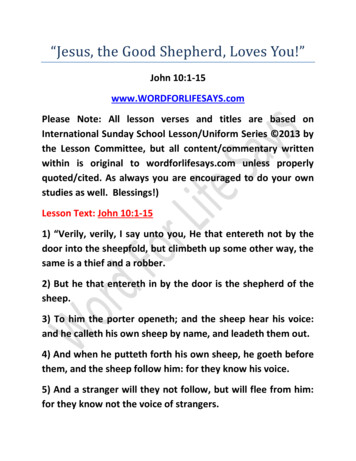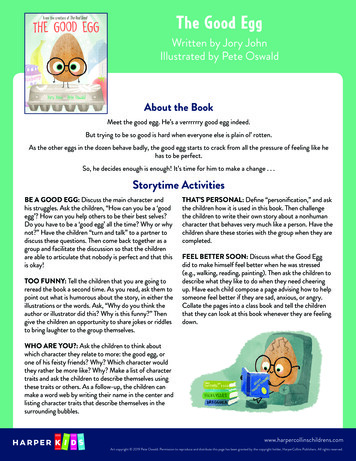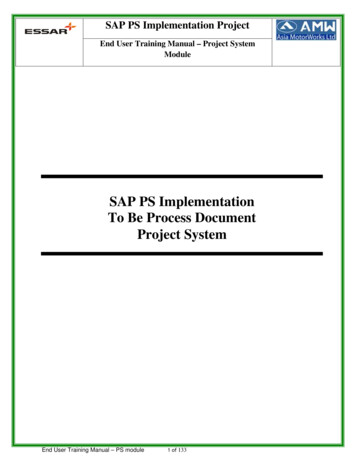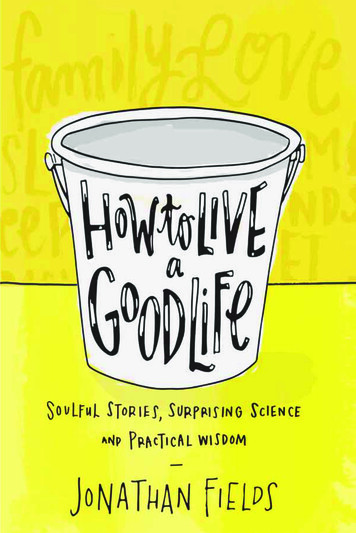
Transcription
EARLY RAVES“Amid the pressure of our everyday routines, it’s easy toforget what mat ters most. We yearn for lives with moreenergy, enthusiasm, and connection —but where to star t? Thebrilliant Jonathan Fields shows us,in this thought-provokingand action-provoking guide. With engaging (and often funny)stor ies, cutt ing- edge research, concrete ideas, and examplesfrom Fields’s own experience, Howto Live a Good Life willinspire readers to star t living their good lives, today.”—Gretchen Rubin, New York Times best-selling author ofThe Happiness Project and BetterThan Before“Many people over the years have considered the questionof how to live a good life, but only one of them is JonathanFields: seeker, leader, thinker, mensch. Drawn from Fields’swide-ranging intellectual sources and deeply kind heart,How to Live a Good Life is the one book you need toanswer the one question that matters.”—Susan Cain, co-founder of Quiet Revolution andNew York Times best-selling author of Quietto doing, then How to Live“Want to move from dreamingirresist ible blend of soul,a Good Life is for you. With anan Fields takes you by thehumilit y, and smart s, Jonathpath to the life you’vehand and walks you down thelclue how to create —one fullonged for but didn’t have ait!”fun . Don’t just read it, liveof meaning, connec tion, andbes t-selling author of—K ris Carr, New York Timeszy Sex y KitchenCraandtCrazy Sex y Die
as from psycholog y,“Jonathan Fields’s book takes ideWestern and Eastern)literature, and philosophy (bothfruit smoothie of wisdom.and blends them into a delicioust to give theirThe book will help those who wanp breaths.”life more meaning, value, and deet-selling author of—A . J. Jacobs, New York Times besan ExperimentAsDrop Dead Healthy and My Life“Jonathan Fields is shining his spotlight onpossibility—not lof ty dreams, not success strategies,not motivational techniques but POSSIBILITY.Straightforward, dynamic, and written with thevitality he wants readers to discoverin themselves,this newest book explains how anyone can live amore energetic, joyful, and passionate life.”—Anna Jedrziewski, Retailing Insight“How to Live a Good Life skillfully pairs potentiality withaction. Fields’s voice is refreshingly down-to-earth, and hisenthusiasm is contagious. My ‘Good Life’ buckets runnethover after reading this book! I’ve drunk The Good LifeKool-Aid and suspect a lot of others will too!”—Kristen Noel, Editor-In-Chief, Best Self
Soulful Stories, Surprising Science,and Pr act ical WisdomJ O N AT H A N F I E L D SHAY HOUSE, INC.Carlsbad, California New York CityLondon Sydney JohannesburgVancouver New Delhi
CONTENTSIntroductionWho Is This Book For?Who Am I to Write This Book, and How Is It Different?Where Do the Ideas I’m about to Share Come From?Let’s Get Your Good Life Going!The Good Life Buckets 115Your Vitality BucketYour Connection BucketYour Contribution BucketThe Three Laws of the BucketsHow to Fill Your Good Life Buckets23Take Your 60-Second SnapshotDraft Your Good Life Project TeamJoin Our Virtual FamilyTwo Paths: Deep Dive or 30-Day ChallengeLet’s Make It HappenFill Your Vitality BucketWake UpMake Exercise More Fun Than SexSnooze to LiveTake a Green DayGet Your Gratitude OnDance Like Nobody’s Watching (Because They’re Not)Own the UnknownTake a Forest BathUn-Fix Your MindTake the Slow Lane31
Fill Your Connection Bucket99Discover Your Social Set PointFind Your PeopleCultivate CompassionLook Up!The 60-Minute Love BombFind Your Four LovesWhat’s Your Love Language?Dial Into SourceVanquish the VampiresUncage Your ConversationFill Your Contribution Bucket159Spark YourselfKnow What MattersTap Your StrengthsFind Your Killer AppGet Out of Your HeadWOOP It UpGive to GlowPractice the Loving NoLove the Job You’re WithThink Ripple, Not WaveAfterword: Bringing It HomeEndnotesBibliographyAcknowledgmentsAbout the Author225
IntroductionI’m the son of a hippie-potter mom and a mad-professor dad.I came of age in the ’70s and ’80s. Growing up, Duran Duran,ripped-jeans, big hair, and Frisbee were my religion. Yes, for thosewho’ve glanced at the head shot of me on the inside cover, therewas a time I had hair. Same cut as Juan Epstein from WelcomeBack, Kotter, and it was #GLORIOUS! I just missed the ’60s free-lovething, but there was still a lot of love in our house.Under the surface, though, as I’d come to learn, things weren’tas I thought. My parents’ marriage was coming apart. Over theyears, my mom had become less hippie and my dad more academic.They wanted different things; they’d become different people.My mom had always been fiercely creative, possessed by the urgeto make stuff. That’s something I inherited from her. Clay washer playground. She’d vanish for days into the basement studio,absorbed in the process of throwing slabs into works of art. As myparents drifted apart, though, life got increasingly complicated.Pulled in many directions, my mom spent less and less time lost inthe embrace of her basement pottery studio, largely abandoningthe consuming devotion to craft that had been her source ofsolace, inspiration, identity, salvation, and even income for somany years. In my junior year of high school, my sister split for1
HOW TO LIVE A GOOD LIFEcollege. Shortly afterward, my dad moved out, leaving my momand me alone together in a big old house.My folks had kept most of the emotional fallout of their separation from us, at least in the early days. Now, mom and I had tofigure out a new dance. She kept up the facade of strength for awhile. Then, one day, it all came tumbling down.I came home to find her sitting on the edge of an old mattressflopped on the floor in the middle of her bedroom—hers alone.Her head lay buried in her knees. Her arms clung to her shins.She was crying. I’d seen her angry plenty of times, especially inthe years leading up to the divorce. But I’d never seen her sittingquietly, lights off, weeping.I didn’t know what to do. For the moment, I was being calledinto the role of caregiver. It was my turn to kiss the boo-boo. But,this wound was soul deep. So I did the only thing I knew. I satnext to her and gently wrapped my arm across her back. “What’swrong?” I asked. In a somber silence that seemed to linger interminably, the unease of reversing roles washed through me. I almosthoped she wouldn’t answer. Then I wouldn’t need to figure outhow to respond. My standard fallback to 17-year-old sarcasmwouldn’t close this gap.“I lost it,” she whispered. “I went downstairs to the studiotoday. I sat at the wheel, grabbed some clay, and tried to throw.I kept trying. But I couldn’t do it. It’s gone.” On the surface, the“it” she was talking about was her near-mystical mastery over clay.Just below that, it was the entirety of her being. Her identity as amaker, an artist, a powerful woman, and a creator. Her ability toreconnect with joy, to play, to get lost in a process, to achieve andbe recognized, to put money in the bank and food on the table.The “it” that had left her was the very essence of who she believedherself to be. Somehow, at 17, I got that.I wanted to cry along with her. Instead, I spoke. I’d trained asa gymnast for years, so this metaphor tumbled clumsily out. “Youhaven’t lost it, Mom; you’re just rusty. It’s like me and gymnastics.You know how I get into great shape for competition during theseason, but then during the off-season I kind of fall apart. Andwhen I come back to training camp the week before we start, I’m2
Introductionpretty terrible. It takes me a few weeks to get everything back. Butit always comes back. Once it’s in you, it’s in you. You’ve beenaway from it for a while. You haven’t lost anything. You’re justrusty. It’ll take a little time to get it back, but you will.”As she listened, the crying began to ease. Her breathing relaxedand she looked up. “Yeah,” she said, “that makes sense.” A spark ofhope emerged, along with a gentle smile, and she gave me a hug.Later that evening, I heard the clank of the basement door as shemade her way back into the studio.I’ve often wondered why this moment has stayed with me.It would be years before I realized what had actually happened.What had been revealed to me. And it would be many moreyears until I gave myself permission to own the possibility thatsomewhere within me lay the ember of a rough-edged ability toaffect others. Both the desire and the potential to create moments,experiences, and things that might inspire a change in state andbelief. To incite possibility.This potential to make a difference is, truth told, somethingI still grapple with. Owning it feels a little too trippy for myrational brain and a little too forward facing and arrogant for mymore introverted, maker self. When my last book was named thenumber-one personal development book of the year by 800-CEOREAD, I was publicly grateful, but privately I recoiled at the labeland what I believed it implied, both about me and about the workI was doing in the world. I’m not that guy, I offered quietly tofriends. I’m about business, entrepreneurship, language, andcreativity. Yet everywhere I’ve turned there have been signs. Youare all those, those same friends would reply, but underneath itall, you’re about something bigger: creating vehicles and pathwaysand moments that allow people to embrace their potential. Toconnect. To reveal. To see and engage with possibility.I’ve come to learn that not owning this part of me out of fearof some kind of external judgment or label—well, that causes itsown pain. It keeps me from doing what I’m here to do. Havingrefused the call for so long (I’m slow; what can I say?), I finallyrealized it was time to step into it.3
HOW TO LIVE A GOOD LIFEThat gradual awakening has fueled years of seeking and studyand fierce engagement with life. It eventually brought me backto my seat not just as a student, but also as a maker, a mentor, awriter, and a teacher. It’s the reason this book exists.Who Is This Book For?I wrote this book with one person in mind but soon discovered she was, in fact, the face, the heart, the soul, and the stifled yearning of millions. From the outside looking in, she had somany reasons to be grateful. A confident woman in her middleyears, she was building a career, had plenty of friends and sharedinterests, and put on a great show of health. She knew she was, inso many ways, blessed. But that did little to quell the undercurrentof yearning and her growing sense of stifled potential. Her deeperreality, like that of so many of us, told a different story.She had given up so much in the name of being an adult andpartner; a source of unflagging, always-on strength and wisdom,kindness and understanding, security and surrender. Everythingto everyone at all times, except herself.What had happened to those deep interests and passions, theburning questions, delicious topics, joyful activities, and momentsof transcendent awe that had been at the center of her youngerlife? They had long been relegated to the land of lost socks andsomedays. Being lit-up ceded the way to being grown-up.Nobody else saw that she was increasingly uncomfortable inher own skin, but she knew. Standing before her mirror revealedmore than clothes could ever hide. It wasn’t just about the wayshe looked; it was about the way she felt. Her health and vitality, her sexual and sensual core, had gone the way of her exerciseand former identity. Her friends, numerous as they were, driftedsomewhere “out there,” wrapped in their own versions of sweetoblivion. Sure, there was the occasional “Let’s do lunch” text, butwithout fail, it would linger unanswered in the digital ether. Shehad her “people,” but having them and being with them were twodifferent things. She was never truly alone but often lonely.4
IntroductionShe met each day overwhelmed with a sense of pervasivebusyness, and fractured attention It was as if a swarm of “interested parties” were in control and her job, from the moment sheopened her eyes to the moment she lay down to sleep, was not tochoose with intention but to mindlessly react to an ever-expanding list of other people’s agendas. Punch lists replaced purposeand possibility. Awakening one morning, she thought, “Welcometo my autopilot life.”Maybe most upsetting was that pervasive sense of untappedpotential, as if the “real” her was screaming to get out, to reclaimthat lit-up self she used to be or silently yearned to become. She’dgive anything to close the gap between the life she knew she wascapable of living and the one that met her every morning. Andshe was gut-tired of answering “busy” and “fine” and “surviving”whenever someone asked, “How are you?” She was desperate to bein a place where she would look up when asked and, with a radiantsmile, reply, “So damn good!”She had flatlined on nearly every level. It was as if she wereliving that classic lyric from Pink Floyd: she’d become “comfortably numb.” For years, she didn’t want to own it. Despite her slowdescent into what Teddy Roosevelt famously described as “thegray twilight that knows neither victory nor defeat,” there wasextraordinary good in her life. She knew this. With so much “real”suffering in the world, she had just written off her state of disillusionment, disconnection, and malaise as a “first-world problem”because it was more about elevation than survival. And who wasshe to complain? Who was she to want more? Framing it this waynot only made her feel greedy for wanting more, but gave her aseemingly rational justification for inaction. But there was something else. If she stood in her deeper truth, if she really ownedit, she’d also have to own both her role in arriving at that placeand her responsibility to do what was necessary to create a different future. And that terrified her, because she had no idea how tobridge the gap between where she was and where she so desperately wanted to be.5
HOW TO LIVE A GOOD LIFEUntil she finally hit her breaking point.I wrote this book for her—but then, I’m guessing if you’ve readthis far, there’s a good chance she is you. Even if you’re a guy.Even if you’re just graduating from college. Even if you’re startingover a bit further into life. We’ve all felt what she felt at differentmoments along the road. We’ve all been in that place of “fine”and “busy,” disconnected from the people, places, and activitiesthat allow us to walk through each day utterly alive. Disconnectedfrom our best selves. We’ve all felt like a piece of us was dying alittle bit every day and we just didn’t know how to flip the switch,how to turn our lives back on. And we’ve all spun the conversation in our heads that justified inaction and complacency. The onethat kept us cocooned, safe from the unknown, but also estrangedfrom the possible.Sadly, we are not alone. In a world where awareness and intention long ago lost the battle to mindless surrender, we’re not eventhe exception. For years, if not decades, we’ve been living with anundiagnosed condition, Reactive Life Syndrome. Living each daynot by choice, but by default. Doing what we can simply to keepup and tread water. It’s not about getting ahead, but rather aboutdesperately trying not to fall too far behind. And in the end, it’sa losing proposition. The great news is that it’s not too late. Thereis an antidote.If you’re nodding and saying, “That’s me. This is what I need.I am ready,” then this book will serve as your guide. The community you’ll discover around the ideas in the book will help ensurethat, maybe for the first time in your life, you’ll move from existing to living, and from knowing what to do to actually doing it.But then, I’m guessing you’ve heard that line before. Andyou’re wondering, “Really? How is this going to give me backmy life? What makes it so different? And who are you to tell mewhat to do?”With your permission, I’ll start with that last question.6
IntroductionWho Am I to Write This Book, and How Is It Different?My finger hovered over the send button. “Who am I,” I wondered, “to propose a book entitled How to Live a Good Life?” Thearrogance! A middle-aged, married dad from the Upper West Sideof Manhattan pontificating on the single most vexing questionin all of human history. What do I have to say about how to livea good life that hasn’t been said or shared a million times before?Funny enough, a large part of my work is helping people andcompanies who’ve lost their sense of identity, voice, and meaninganswer this very question. Who am I to have something to say? As Isat with the question, the words of iconic dancer and choreographer Martha Graham, offered in Agnes de Mille’s biography, Martha: The Life and Work of Martha Graham, settled over me:There is vitality, a life force, energy, a quickening thatis translated through you into action, and because there isonly one of you in all of time, this expression is unique.And if you block it, it will never exist through any othermedium and it will be lost. The world will not have it. Itis not your business to determine how good it is nor howvaluable nor how it compares with other expressions. It isyour business to keep it yours clearly and directly, to keepthe channel open. You do not even have to believe in yourself or your work. You have to keep yourself open and awareto the urges that motivate you. Keep the channel open. . . .Adding value to another’s life is not about being a guru, a sage,or a wizard. It’s not about placing yourself above others, preachingdown, or telling anyone to “sit and listen while I save you fromthe world and yourself.” When I look at the astonishing body ofwisdom around the pursuit of a good life, from the Stoics to theBuddha, from faith to science and metaphysics to mythology, it’sclear to me that there is little, if anything, that’s not been studied or said before. There are precious few new ideas. Yet, in theface of this gob-smackingly huge collection of wisdom, much ofhumanity stumbles along, eternally yearning for a life it knows ispossible, but having no idea how to find or create it.7
HOW TO LIVE A GOOD LIFEThe problem isn’t that we don’t have the answers. We’ve hadthem for thousands of years. It’s that the things that work are eitherengulfed in a vast sea of noise or offered in a way that doesn’t land.They’re too hard to find and validate, too complicated, too theoretical, too mired in dogma, that war with the reality of our lives.I’m not here to claim ownership of something profound andnew, but rather to help you separate the wheat from the chaff. Toidentify the big levers, the things that work. And then to sharethem in a way that preserves their potential but also goes downeasy. A way that inspires not just understanding, but action andintegration, without the need for blind faith, godlike willpower,or total disruption.My role has been to live fiercely and study deeply. To walkthrough each day an eternal student. To wade into Joseph Campbell’s disquieting abyss in search of our treasure. Hopefully theway I share my unique understanding and experience will somehow connect with the way you need to hear or see or feel something at this moment. Maybe some small piece will awaken a partof your story in a manner that helps you breathe a little easier, lovea little more openly, or live a little more fully. That is my intentionin writing this book.But what about you? All I ask is this: Stay open. Hold on alittle less tightly to the safety of a consistent yet failed past and tothe perceived sanctity of truths that may or may not have servedyou and the way you dream of being in the world. As Mark Twainfamously offered, “It ain’t what you don’t know that gets you intotrouble. It’s what you know for sure that just ain’t so.”Where Do the Ideas I’m about to Share Come From?In the next chapter, I’ll offer a simple model that you can useto guide nearly every decision in life, something I call the GoodLife Buckets. Where does it come from? In part, from decades ofstudy. Some at the feet of extraordinary thinkers and teachers,from Buddhist lamas to education reformers and grounded-theory researchers to neuroscientists. Other learning comes from8
Introductionthousands of hours and decades of quiet study and contemplation, devouring everything from Thomas Merton to the BhagavadGita to reams of academic studies and research reports.Then there’s the wisdom that can come only from some 50years of life. Lessons learned through more than two decadesbuilding communities and companies, failing repeatedly andfinding the will to step back into the arena until I got it right.Years teaching everything from yoga to entrepreneurship to thousands of students from around the world, speaking on stages largeand small, working with everyone from soccer moms to CEOsand movie stars to moguls, leading retreats, writing books, andlecturing at universities. But without question, my deepest, mosthumbling growth has come from being a dad and a husband, andfrom my daily practice, one that cultivates a deepening stillnessand continues to awaken me to the life-affirming truth of my ownimpermanence and the urgency that comes from accepting thaton a day unknown to me, I and all those I love will be gone. Eachof these experiences has shaped what Martha Graham would callmy unique expression of life. My quickening. My channel. Andthey’ve all found an outlet in the venture that now commands agood part of my vocation, Good Life Project .In January 2012, I began to write what had normally been anannual essay that inventoried and reflected on the year behindand set intentions for the year to come. That document rapidlygrew into a 34-page Warren Buffet–style annual report that I published and shared on my blog. On the final two pages, entitled“2012 Reimagined,” I shared a story, and an invitation:“What inspires you?”That’s what an audience member asked during mykeynote at a conference last summer.Little did she know, I had something hidden . . . something the audience couldn’t see . . . a little piece of paperresting on the monitor next to my notes . . .It was there to remind me what really mattered. I couldcrash and burn on stage, but this piece of paper wouldmake it all okay.9
HOW TO LIVE A GOOD LIFEIt was a heart. Drawn for me by my 10-year old daughter before I left. No matter how my keynote went, she’dstill be there to place her hands on my cheeks when Iwalked in the door and share a few butterfly kisses and ahug that said, “You’re everything I need.”I held up the heart in response to the question andsaid, “This. My daughter,” then explained what it was.Standing there, with the piece of paper raised high inthe air before 500 people, I nearly burst into tears. So didmany in the audience.That piece of paper with the hastily drawn heart comes withme when I travel. If I’m on stage, it’s there with me. But there wasmore. An invitation bundled with an announcement. Ten ideas,a different approach to building not just a living, but a life. Anda new venture, one that would take my (until then) very personalexploration of life well lived and turn it far more public than I’dever planned.“What if I shared my quest,” I thought. Sitting down withteachers, known and unknown, filming and recording the conversations, then not only learning but offering these people andideas up to the world. What if I made it my full-time pursuit tofind, learn from, and share people with pieces of the puzzle? People like the ephemerally wise and wickedly funny Brené Brown.People like polio survivor and education revolutionary Sir KenRobinson. People like Shambhala Buddhist lama Sakyong Mipham Rinpoche, a fiftysomething Tibetan lama whose name literally translates to “Earth Protector.” People like iconic graphicdesigner Milton Glaser, who, when I sat down with him at the ageof 85 remained stunningly prolific, deeply committed, creating,teaching, and playing with his wife of some 60 years. People likeacclaimed illustrator Lisa Congdon, who stumbled into art in herthirties and made it her life. Or famed behavioral economist andpsychologist Dan Ariely, whose fascination with human natureand subsequent vocation were triggered by a three-year stint asa patient in an Israeli burn ward at the age of 18. What if I couldtravel the world, visit with these beacons of life-earned wisdom10
Introductionand light, learn at their feet, integrate what I learned with my ownexperience of life, my own unique view, voice, and channel, andthen share it all with the world?With that, Good Life Project was born. And without intention, the very early seeds of this book were planted. Now yearsinto this quest, those seeds of an idea that began as a deep yearning to learn and share have grown into a media and educationventure with a global community, an acclaimed web series andpodcast with hundreds of thousands of listeners and viewers inmore than 150 countries. We’ve also grown a catalog of courses,gatherings, events, and even an annual celebration, Camp GLP,where “GLeePers” from all over the world converge on a summercamp for three and a half days of pure magic.Along the way, the incredible access to extraordinary mindsand gorgeous souls began to cross-pollinate with my own experiences, and something profound began to emerge, a simple modelI began to call the Good Life Buckets . This easy-to-digest framework offers a way to look at the life you’re living, quickly andeasily assess what’s working and what’s not, and instantly knowwhere to focus your energy to make things better; then it tellsyou what to do. I began to share the Good Life Buckets withincreasingly large groups and within our courses and gatherings.The response took my breath away.Mel Charbonneau, a married mother of three young kids andcofounder of the emerging women’s movement Fellow Flowers,was one of the first to learn about the buckets. In the middle ofone of our intensive seven-month training programs, she sharedsome great news. She was pregnant with her third child. And,much to my surprise, the Good Life Buckets played a major rolein both her decision to have another child and how she wouldcompletely reconfigure her life to continue to flourish as a momand an entrepreneur and live a great life. In her words:Having another child was a big deal. I’m in majorstart-up mode with my business, giving it a ton of mytime, creativity, and energy. And I already have two little girls, ages 7 and 4, who get all my love and attention11
HOW TO LIVE A GOOD LIFEwhen I’m not in biz mode. My husband and I had justfigured out our groove with family and business when Irealized something big—I really wanted to have anotherbaby. How do you have that conversation?How do you discuss those big pieces of your life thatwill have to once again get reacclimatized? Enter the buckets. When I returned home from Costa Rica, it was likeI had a whole new dialogue to share with my husband,which helped guide our decision and reaffirm what wasmost important to us. It gave us context for questions andconversation. . . . It actually became really good motivation to pause, prioritize, and let go of a few things. For ourmarriage, it brought us closer because connection (familyrelationships) is the MOST important part of our life, andnow our goal is to make a contribution and vitality support and nurture that, leaving room for the fun, chaos,and adventures of life.Charbonneau is just one of so many examples. As more people learned about the Good Life Buckets , I noticed somethingwonderful. They began speaking in “the language” of the buckets—“I’m feeling like this one bucket needs filling today”—andusing it to guide their decisions, big and small. The outcomes werebetter than I ever imagined, and with its application in the realworld, I’ve been able to refine the model. This book is your windowinto this seemingly simple yet transformational tool, explaininghow you can tap the buckets to guide your decisions and actionsin the quest to live a great life.Let’s Get Your Good Life Going!It’s time to set in motion your personal Good Life Project. Todiscover a new way to get from where you are now to where youknow in your bones you’re capable of being.Before we dive in, one last thought: This book is your roadmap. The approach, ideas, and many invitations to act, to play, to12
Introductionconnect, and to embody what you’re learning on a daily basis willserve as a hybrid good life manifesto and a practical yet powerfulguide. One that allows you to ease into a process of awakening andbecoming in a way that feels right to you.At the same time, the real magic happens when you putdown the book and start doing the work. So I’ve created a set ofadditional resources not only to ensure you stay supported, feelinspired, and are held while you’re “doing” the book, but also tohelp you carry the learning and doing into the rest of your life.Throughout the book, you’ll see references to a web page calledgoodlifeproject.com/bookinsider. Here, I’ll share a wide range offree resources, links, downloadable files, worksheets, guided audio,and more, all in one place. You’ll also find an invitation to joinour beautiful, supportive, and private Good Life Project onlinecommunity, crafted around an ethos of generosity, compassion,nonjudgment, and elevation. There you’ll find a place to shareyour experiences, ask questions, find accountability partners andsupport, and more. Oh, and don’t be surprised if you also end upmaking a bunch of friends along the way. Our “GLeePer” familyhas been known to be a pretty friendly lot!Onward then—to the buckets we go!13
HOW TO LIVE A GOOD LIFEThe Good Life Buckets Think of your life as three buckets.The first bucket is called Vitality, and it’s about the state ofyour mind and body. The second is Connection; this one is aboutrelationships. The third, Contribution, is about how you contribute to the world.The fuller your buckets, the better your life. When all simultaneously bubble over, life soars. That’s what we’re aiming for.But the flip side is also
“How to Live a Good Life skillfully pairs potentiality with action. Fields’s voice is refreshingly down-to-earth, and his enthusiasm is contagious. My ‘Good Life’ buckets runneth over after reading this book! I’ve drunk The Good Life Kool-Aid and suspect a lot of ot


